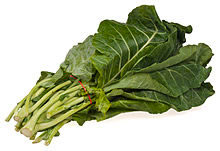Perhaps nowhere in the United States have greens been so beloved as in the South. South Carolina has a long history of cooking greens — typically collards, turnip greens, and some wild leaf greens.
 Greens came to South Carolina from around the world. Collards are widely believed to have arrived here from Africa via the slave route, and turnips, originally eaten more than thirteen hundred years ago, made their way from Asia. England’s love of greens is also reflected in our cuisine. Some greens, such as poke salat and dandelion greens grow wild. Others are the tops of a vegetable (beet tops and turnip tops) while others are loose greens (some varieties of turnips that have no root vegetable) or headed greens (cabbage). A complete list of other greens might include collards’ cousin kale (also known as cole, colewort, Dutch kool, German kohl and English cole, collarats, and collard-leaves), cabbage sprouts, beet tops, mustard greens, broccoli raab (also called rape and turnip broccoli), and spinach. Cabbage is not commonly included among “greens.” Any and all of the above can and are used separately or in conjunction with the traditional collards and turnip greens. Turnip and collard greens are considered better after a frost.
Greens came to South Carolina from around the world. Collards are widely believed to have arrived here from Africa via the slave route, and turnips, originally eaten more than thirteen hundred years ago, made their way from Asia. England’s love of greens is also reflected in our cuisine. Some greens, such as poke salat and dandelion greens grow wild. Others are the tops of a vegetable (beet tops and turnip tops) while others are loose greens (some varieties of turnips that have no root vegetable) or headed greens (cabbage). A complete list of other greens might include collards’ cousin kale (also known as cole, colewort, Dutch kool, German kohl and English cole, collarats, and collard-leaves), cabbage sprouts, beet tops, mustard greens, broccoli raab (also called rape and turnip broccoli), and spinach. Cabbage is not commonly included among “greens.” Any and all of the above can and are used separately or in conjunction with the traditional collards and turnip greens. Turnip and collard greens are considered better after a frost.
All greens must be washed thoroughly to avoid grittiness. The traditional southern method of cooking collards and turnips is to make a broth with fatback, streak o’lean, ham hocks, or other salted pork or bacon and water (sometimes hot peppers are included). The greens are stripped of tough or yellowed stems and leaves and added to the boiling water. The heat is reduced and the greens left to simmer for up to two hours. They are then cut into smaller pieces, and served hot, sometimes with the pork fried and served as well. Modern cooks frequently substitute chicken broth for the pork. Vinegar with chipped onions, tomato preserves or hot pepper sauce is frequently kept on the table for seasoning the greens. The pot liquor may be used as a broth or served with the greens in a side dish or bowl.
Greens are highly nutritious; a source of riboflavin, calcium, and iron as well as vitamins A and C. It is thought that the use of salt pork was also important to the diet of southerners in the early days of settlement and following the Civil War, when meat was scarce. When served on New Year’s Day, greens are considered a promise of “greenbacks” in the coming year.
New varieties of turnips are now also eaten lightly blanched or, if very tender and young, raw in salads. There are myriad other ways of cooking greens, including blanching and sautéing quickly, or, in the case of spinach, sweated over heat for just a few minutes in the moisture still on the leaves after washing.
— Excerpted from the entry by Nathalie Dupree. To read more about this or 2,000 other entries about South Carolina, check out The South Carolina Encyclopedia by USC Press. (Information used by permission.)


